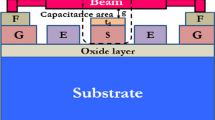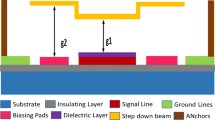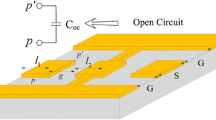Abstract
In this paper, we have developed an analytical model for capacitance measurement of step structure perforated RF MEMS Switch. Capacitance model plays an important role to design and fabricate a high-performance of RF MEMS switches. Modelling signifies the validation of the proposed switch to design before fabrication by comparing the analytical and simulated results. Here, an analytical capacitance model for step structure perforated RF MEMS Switch is proposed based on ligament efficiency. The total capacitance of the switch is formulated with the parallel-plate capacitance developed by the total surface area of the electrodes and fringing field capacitance developed by sidewalls of the beam edges and perforations. The percentage of error is calculated to analyse the accuracy of the proposed model. The proposed capacitance model is verified by varying the switch design parameters such as dielectric thickness, the gap between electrodes, beam thickness and ligament efficiency. The percentage of error by the proposed model is compared with the two benchmark models and the obtained results shows good agreement than the benchmark models.




















Similar content being viewed by others
References
Addabbo T, Fort A, Mugnaini M, Rocchi S, Vignoli V (2015) Improved model for the capacitance estimation of guarded capacitive sensors. In: XVIII AISEM Annual Conference 2015. https://doi.org/10.1109/aisem.2015.7066772
Ali I (2012) Modelling and simulation of MEMS components: challenges and possible solutions. https://doi.org/10.5772/32122
Guha Koushik, Kumar Mithlesh, Agarwal Saurabh, Baishya Srimanta (2015) A modified capacitance model of RF MEMS shunt switch incorporating fringing field effects of the perforated beam. Solid State Electron 114:35–42
Hosseini M, Zhu G, Peter YA (2007) A new formulation of fringing capacitance and its application to the control of parallel-plate electrostatic micro actuators. Analog Integr Circ Signal Process 53(2–3):119–128. https://doi.org/10.1007/s10470-007-9067-3
Huynh C, Nguyen C (2011) New ultra-high-isolation RF switch architecture and its use for a 10–38-GHz 0.18 µm BiCMOS ultra-wideband switch. IEEE Trans Microw Theory Tech 59(2):345–353. https://doi.org/10.1109/tmtt.2010.2097732
Kumar A, Chaurasia N, Mehra R (2015) Design and EM modeling of RF MEMS switches. Int J Eng Trends Tech (IJETT) 25(4):186–195
Leus Vitaly, Elata David (2004) Fringing field effect in electrostatic actuators. In: Technical report ETR-2004-2, Israel Institute of Technology, Faculty of Mechanical Engineering
Matrecano M, Memmolo P, Miccio L, Persano A, Quaranta F, Siciliano P, Ferraro P (2015) Improving holographic reconstruction by automatic Butterworth filtering for microelectromechanical systems characterization. Appl Opt. https://doi.org/10.1364/ao.54.003428
Mercado L, Koo S-M, Lee T-YT, Liu L (2003) A mechanical approach to overcome RF MEMS switch stiction problem. In: Proceedings of 53rd Electronic Components and Technology Conference, pp 377–384. https://doi.org/10.1109/ectc.2003.1216305
Persano A, Quaranta F, Capoccia G, Proietti E, Lucibello A, Marcelli R, Sciliano P (2016) Influence of design and fabrication on RF performance of capacitive RF MEMS switches. Microsyst Tech 22(7):1741–1746. https://doi.org/10.1007/s00542-016-2829-z
Tazzoli A, Peretti V, Gaddi R, Gnudi A, Zanoni E, Meneghesso G (2006) Reliability issues in RF-MEMS switches submitted to cycling and ESD test. IEEE Int Reliab Phys Symp Proc. https://doi.org/10.1109/relphy.2006.251253
Tilmans HAC, Raedt WD, Beyne E (2003) MEMS for wireless communications: from RF-MEMS components to RF-MEMS-SiP. J Micromech Microeng 13(4):139–163. https://doi.org/10.1088/0960-1317/13/4/323
Van de Meijs N, Fokkema JT (1984) VLSI circuit reconstruction from mask topology. Integration 2(2):85–119
Yadav Rekha, Yadav Rajesh, Nehra Vijay, Rangara KJ (2011) RF MEMS switches fabrication, key features, application and design tools. Int J Electron Eng 3(2):179–183
Yang H (2000) Microgyroscope and microdynamics, Ph.D Dissertation; December 2000
Acknowledgements
The Authors would like to thank to NMDC supported by NPMASS, National Institute of Technology, Silchar for providing the necessary computational tools.
Author information
Authors and Affiliations
Corresponding author
Additional information
Publisher's Note
Springer Nature remains neutral with regard to jurisdictional claims in published maps and institutional affiliations.
Rights and permissions
About this article
Cite this article
Sravani, K.G., Guha, K. & Rao, K.S. An analytical capacitance modeling of step structured perforated RF MEMS switch. Microsyst Technol 28, 771–778 (2022). https://doi.org/10.1007/s00542-019-04578-x
Received:
Accepted:
Published:
Issue Date:
DOI: https://doi.org/10.1007/s00542-019-04578-x




